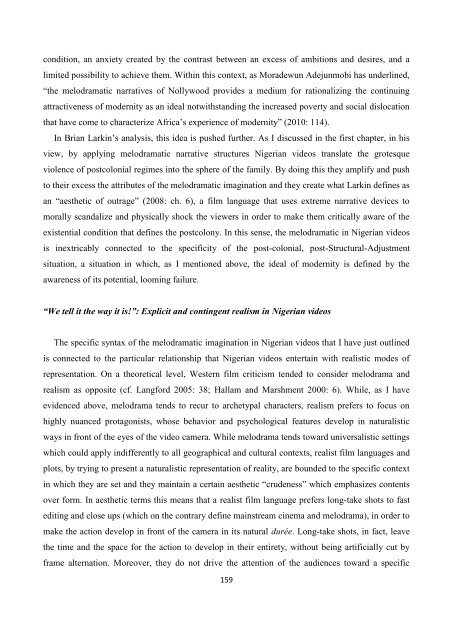You also want an ePaper? Increase the reach of your titles
YUMPU automatically turns print PDFs into web optimized ePapers that Google loves.
condition, an anxiety created by the contrast between an excess of ambitions and desires, and alimited possibility to achieve them. Within this context, as Moradewun Adejunmobi has underlined,“the melodramatic narratives of Nollywood provides a medium for rationalizing the continuingattractiveness of modernity as an ideal notwithstanding the increased poverty and social dislocationthat have come to characterize Africa’s experience of modernity” (2010: 114).In Brian Larkin’s analysis, this idea is pushed further. As I discussed in the first chapter, in hisview, by applying melodramatic narrative structures Nigerian videos translate the grotesqueviolence of postcolonial regimes into the sphere of the family. By doing this they amplify and pushto their excess the attributes of the melodramatic imagination and they create what Larkin defines asan “aesthetic of outrage” (2008: ch. 6), a film language that uses extreme narrative devices tomorally scandalize and physically shock the viewers in order to make them critically aware of theexistential condition that defines the postcolony. In this sense, the melodramatic in Nigerian videosis inextricably connected to the specificity of the post-colonial, post-Structural-Adjustmentsituation, a situation in which, as I mentioned above, the ideal of modernity is defined by theawareness of its potential, looming failure.“We tell it the way it is!”: Explicit and contingent realism in Nigerian videosThe specific syntax of the melodramatic imagination in Nigerian videos that I have just outlinedis connected to the particular relationship that Nigerian videos entertain with realistic modes ofrepresentation. On a theoretical level, Western film criticism tended to consider melodrama andrealism as opposite (cf. Langford 2005: 38; Hallam and Marshment 2000: 6). While, as I haveevidenced above, melodrama tends to recur to archetypal characters, realism prefers to focus onhighly nuanced protagonists, whose behavior and psychological features develop in naturalisticways in front of the eyes of the video camera. While melodrama tends toward universalistic settingswhich could apply indifferently to all geographical and cultural contexts, realist film languages andplots, by trying to present a naturalistic representation of reality, are bounded to the specific contextin which they are set and they maintain a certain aesthetic “crudeness” which emphasizes contentsover form. In aesthetic terms this means that a realist film language prefers long-take shots to fastediting and close ups (which on the contrary define mainstream cinema and melodrama), in order tomake the action develop in front of the camera in its natural durée. Long-take shots, in fact, leavethe time and the space for the action to develop in their entirety, without being artificially cut byframe alternation. Moreover, they do not drive the attention of the audiences toward a specific159
















